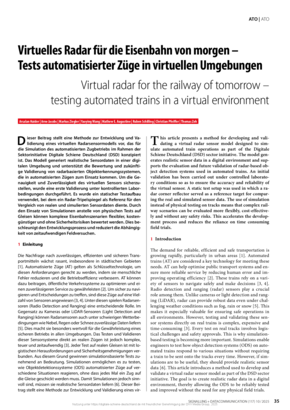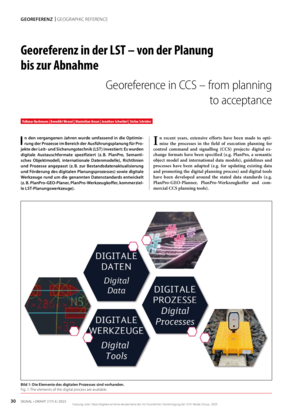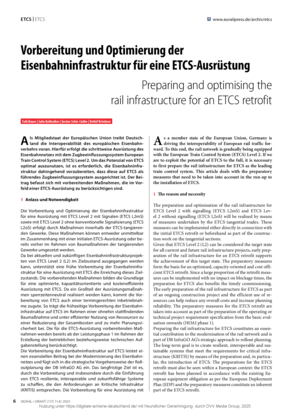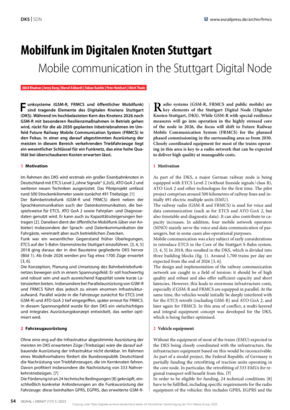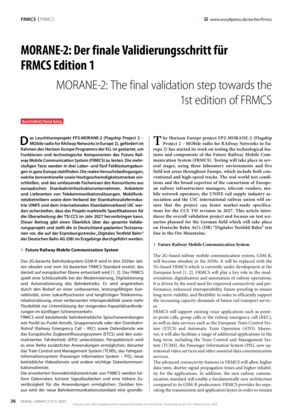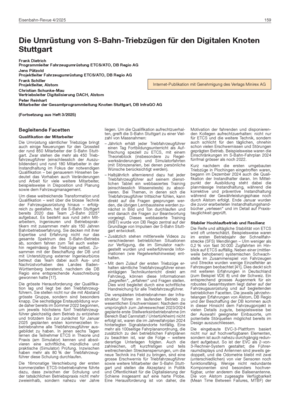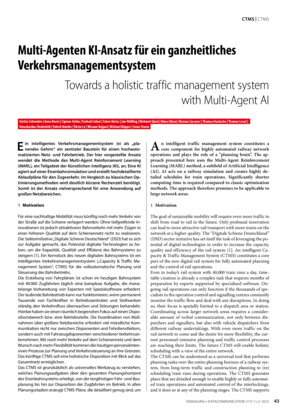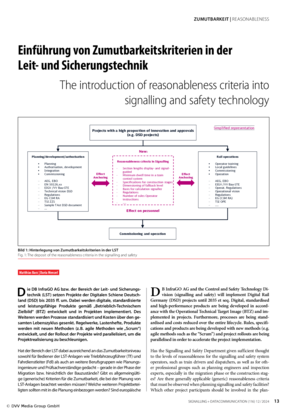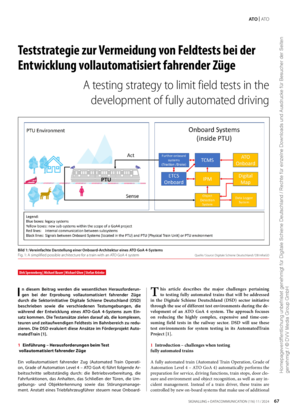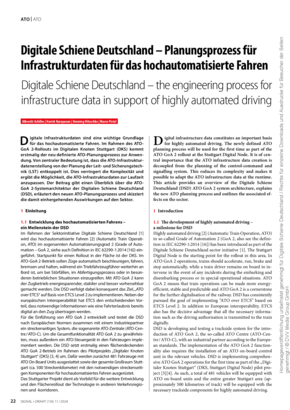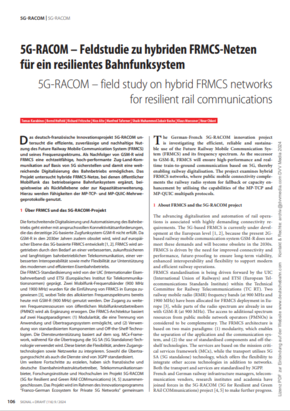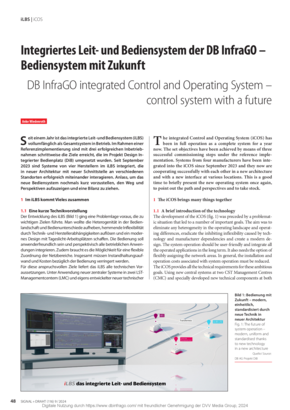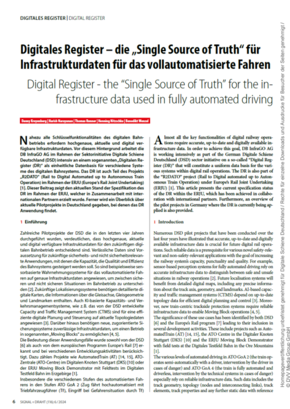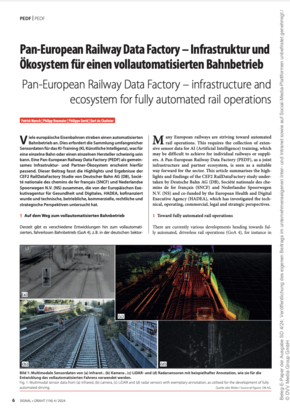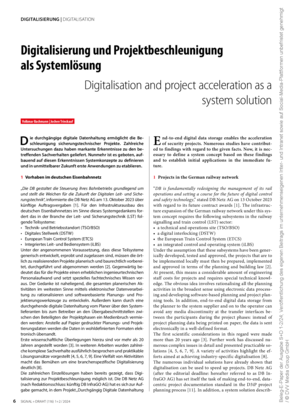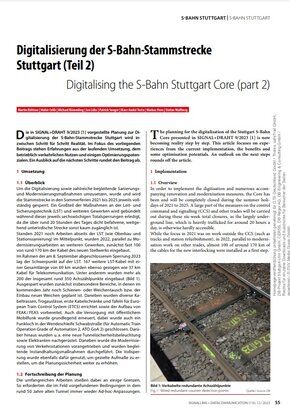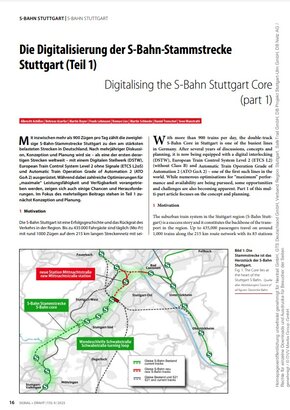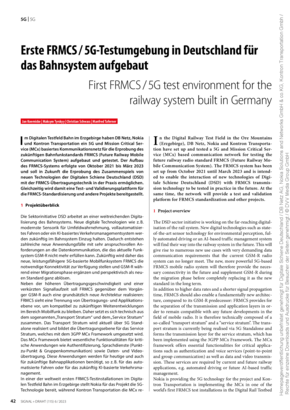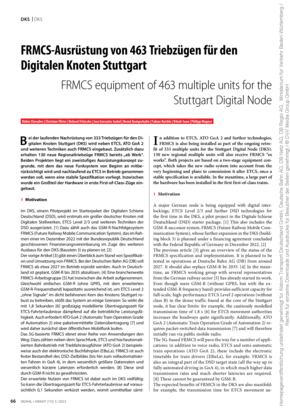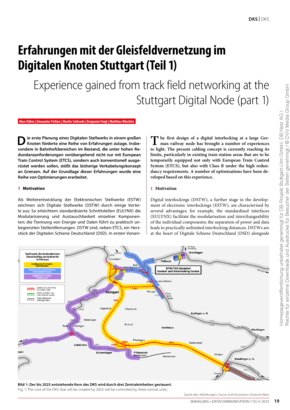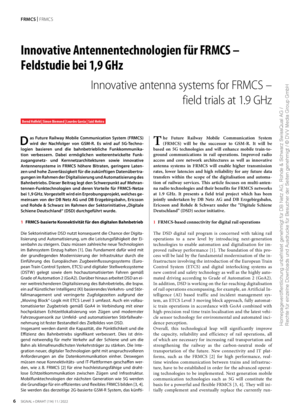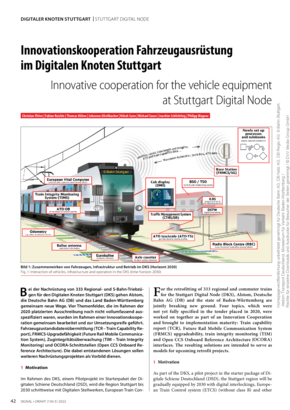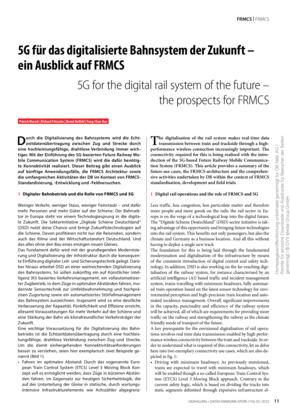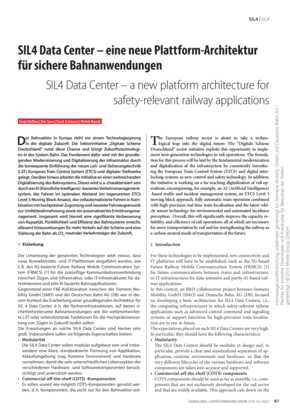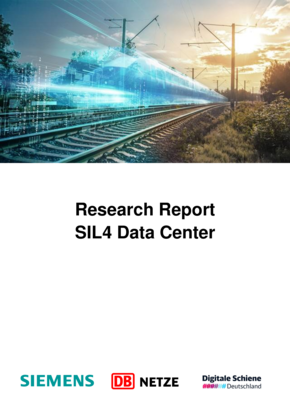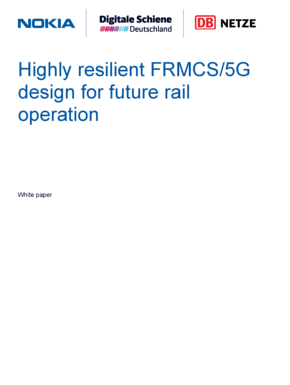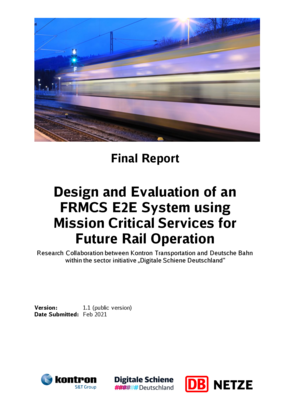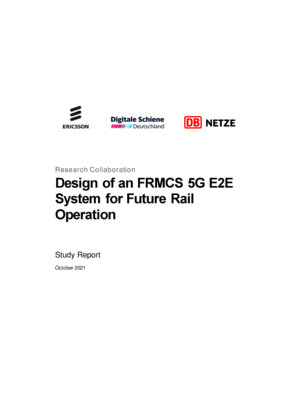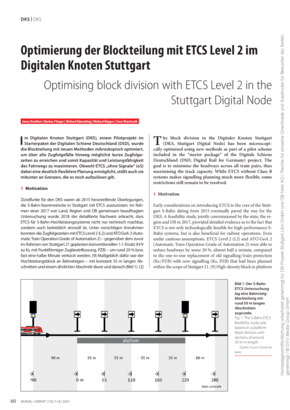Media Library
We are constantly writing articles in cooperation with trade magazins, which are unfortunately only published in German. Therefore you can only find publications in german.
Reports & Whitepapers
-
Virtual radar for the railway of tomorrow – testing automated trains in a virtual environment | October 2025
This article presents a method for developing and validating
a virtual radar sensor model designed to simulate
automated train operations as part of the Digitale
Schiene Deutschland (DSD) sector initiative. The model generates
realistic sensor data in a digital environment and supports
the evaluation and future validation of radar-based object
detection systems used in automated trains.Source: SIGNAL+DRAHT
-
Georeference in CCS – from planning to acceptance | June 2025
In addition to the direct benefits (such as loss-free data transfer, automation potential and trade synchronisation), the digital process has additional effects thanks to the georeferenced basis of the digital data. The result is a seamless interlinking of existing data, planning data and construction information so that any deviation between the planning and realisation is known and comprehensibly documented for all the infrastructure elements at every stage of the project. This creates continuous quality assurance right up to acceptance.
Source: SIGNAL+DRAHT
-
Preparing and optimising the rail infrastructure for an ETCS retrofit | July/August 2025
As a member state of the European Union, Germany is driving the interoperability of European rail traffic forward. To this end, the rail network is gradually being equipped with ETCS. If we are to exploit the potential of ETCS to the full, it is necessary to first prepare the rail infrastructure for ETCS as the leading train control system. This article deals with the preparatory measures that need to be taken into account in the run-up to the installation of ETCS.
Source: SIGNAL+DRAHT
-
Mobile communication in the Stuttgart Digital Node | May 2025
Radio systems (GSM-R, FRMCS and public mobile) are key elements of the Stuttgart Digital Node (Digitaler Knoten Stuttgart, DKS). While GSM-R will go into operation in the highly stressed core of the node in 2026, the focus will shift to Future Railway Mobile Communication System (FRMCS) for he planned phased commissioning in the surrounding area as from 2030.
Source: SIGNAL+DRAHT
-
MORANE-2: The final validation step for FRMCS Edition 1 | May 2025
The lighthouse project FP2-MORANE-2 has been launched to test the functions and technological components of the Future Railway Mobile Communication System (FRMCS). This article provides an overview of the entire validation project and presents the test scenarios planned in Germany, which will be carried out on the "Digitales Testfeld Bahn" test track of Deutsche Bahn AG (DB) in the Erzgebirge.
Source: SIGNAL+DRAHT
-
The conversion of S-Bahn multiple units for the Digital Hub Stuttgart Part 1/2 | March 2025
The Stuttgart S-Bahn fleet is being upgraded for the Digital Hub Stuttgart. The Class 423 and 430 multiple units will be upgraded in several stages with ETCS, ATO GoA 2, and FRMCS, among other features. The first part of the longest DKS technical article to date describes the history of the upgrade project, from conception to ongoing implementation and the technology.
Source: Eisenbahn-Revue International, Eisenbahn Österreich, Schweizer Eisenbahn-Revue
-
The conversion of S-Bahn multiple units for the Digital Hub Stuttgart Part 2/2 | March 2025
The Stuttgart S-Bahn fleet is being upgraded for the Digital Hub Stuttgart. The Class 423 and 430 multiple units will be upgraded in several stages with ETCS, ATO GoA 2, and FRMCS, among other features. The first part of the longest DKS technical article to date describes the history of the upgrade project, from conception to ongoing implementation and the technology.
Source: Eisenbahn-Revue International, Eisenbahn Österreich, Schweizer Eisenbahn-Revue
-
Towards a holistic traffic management system with Multi-Agent AI | March 2025
An intelligent traffic management system constitutes a core component for highly automated railway network operations and plays the role of a “planning brain”. The approach presented here uses the Multi-Agent Reinforcement Learning (MARL) method, a subfield of Artificial Intelligence (AI). AI acts on a railway simulation and creates highly detailed schedules for train operations. Significantly shorter computing time is required compared to classic optimisation methods. The approach therefore promises to be applicable to large network areas.
Source: SIGNAL+DRAHT
-
The introduction of reasonableness criteria into signalling and safety technology | December 2024
DB InfraGO AG and the Control and Safety Technology Division will implement Digitale Schiene Deutschland projects until 2035 et seq. Digital, standardisedand high-performance products are being developed in accordance with the Operational Technical Target Image and implemented in projects. Furthermore, processes are being standardised and costs reduced over the entire lifecycle. Rules, specifications and products are being developed with new methods (e.g. “Scrum”) and project rollouts are being parallelised in order to accelerate the project implementation.
Source: SIGNAL+DRAHT
-
A testing strategy to limit field tests in the development of fully automated driving | November 2024
This article describes the major challenges pertaining to testing fully automated trains that will be addressed at DSD using different test environments during the development of an ATO GoA 4 system. The approach focuses on reducing the highly complex, expensive, and time-consuming field tests in the railway sector. DSD will use these test environments for system testing in its AutomatedTrain project.
Source: SIGNAL+DRAHT
-
The engineering process for infrastructure data in support of highly automated driving | November 2024
The newly defined ATO planning process will be used for the first time as part of the ATO GoA 2 rollout at the Stuttgart Digital Node. This article provides an overview of the Digitale Schiene Deutschland (DSD) ATO GoA 2 system architecture, explains the new ATO planning process and outlines the associated effects on the sector.
Source: SIGNAL+DRAHT
-
5G-RACOM - Field study on hybrid FRMCS networks for a resilient railway radio system | September 2024
The Franco-German innovation project 5G-RACOM is investigating the efficient, reliable and sustainable utilisation of the FRMCS and its frequency spectrum. As the successor to GSM-R, FRMCS will ensure real-time, high-performance train-to-ground communication based on 5G and thus enable the far-reaching digitalisation of rail operations.
Source: SIGNAL+DRAHT
-
DB InfraGO integrated Control and Operating System – control system with a future | September 2024
The integrated Control and Operating System (iCOS) has been in full operation as a complete system for a year now. The set objectives have been achieved by means of three successful commissioning steps under the reference implementation. Systems from four manufacturers have been integrated into the iCOS since September 2023 and they now are cooperating successfully with each other in a new architecture and with a new interface at various locations.
Source: SIGNAL+DRAHT
-
Digital Register - the "Single Source of Truth" for the infrastructure data used in fully automated driving | June 2024
Almost all key functionalities of the digital rail system require highly accurate, up-to-date and digitally available infrastructure data. This is why Digitale Schiene Deutschland is working intensively on a so-called "Digital Register (DR)". It is being specified and standardized as part of the European initiative Europe's Rail Joint Undertaking (ERJU). This should enable all European railroads to access compatible infrastructure data in the future.
Source: SIGNAL+DRAHT
-
Pan-European Railway Data Factory – infrastructure and ecosystem for fully automated rail operations | April 2024
Many European railways are striving toward automated rail operations. This requires the collection of extensive sensor data for AI training. A Pan-European Railway Data Factory (PEDF), as a joint infrastructure and partner ecosystem, is seen as a suitable way forward for the sector. This article summarises the highlights and findings of the CEF2 RailDataFactory study undertaken by Deutsche Bahn AG (DB), Société nationale des chemins de fer français (SNCF) and Nederlandse Spoorwegen N.V. (NS).
Source: SIGNAL+DRAHT
-
Digitalisation and project acceleration as a system solution | February 2024
End-to-end digital data storage enables the acceleration of security projects. Numerous studies have contributed to findings with regard to the given facts. Now, it is necessary to define a system concept based on these findings and to establish initial applications in the immediate future.
Source: SIGNAL+DRAHT
-
Artificial Intelligence for the traffic management system of the future | January, February 2024
An intelligent Traffic Management System is a fundamental centerpiece of future digitalized railway network operations. When thousands of trains are on the move in dense traffic, rapid decisions must be made to adjust the operations in the event of disruptions. New approaches are needed in order to be able to respond quickly and effectively to disturbances in future railway operations. Combining Artificial Intelligence (AI) and methods from Operations Research can help address this challenge. This approach was tested on a specific application.
Source: SIGNAL+DRAHT
-
Digitalising the S-Bahn Stuttgart Core (part 2) | December 2023
The plans presented in SIGNAL+DRAHT 9/2023 for the digitalisation of the Stuttgart S-Bahn main line are now gradually becoming reality. This article focuses on experiences from the ongoing implementation, the operational and transport benefits and some optimisation potential. An outlook on the next steps rounds off the article.
Source: SIGNAL+DRAHT
-
Digitalising the S-Bahn Stuttgart Core (part 1) | September 2023
With more than 900 trains per day, the double-track S-Bahn main line in Stuttgart is one of the busiest routes in Germany. After several years of discussion, design and planning, it is one of the first such lines in the world to be equipped with a digital interlocking system (DSTW), European Train Control System Level 2 without signals (ETCS L2oS) and Automatic Train Operation Grade of Automation 2 (ATO GoA 2).
Source: SIGNAL+DRAHT
-
First FRMCS/5G test environment for the railway system built in Germany | June 2023
In the Digital Railway Test Field in the Ore Mountains (Erzgebirge), DB Netz, Nokia and Kontron Transportation have set up and tested a 5G and Mission Critical Service (MCx) based communication network for testing the future railway radio standard FRMCS (Future Railway Mobile Communication System).
Source: SIGNAL+DRAHT
-
Deliverable "D1 – Data Factory Concept, Use Cases and Requirements" | June 2023
The "pan-European Railway Data Factory" is a kind of ecosystem with a common infrastructure that enables railroad companies and manufacturers to collect, process, use and simulate sensor data europewide.
-
Article in "Signal & Draht" | FRMCS equipment of 463 multiple units for the Stuttgart Digital Node | 05/23
In addition to ETCS, ATO GoA 2 and further technologies, FRMCS is also being installed as part of the ongoing retrofit of 333 multiple units for the Stuttgart Digital Node (DKS). 130 new regional multiple units will also receive FRMCS “ex works”. In the meantime, a large part of the hardware has been installed in the first first-of-class trains.
Source: SIGNAL+DRAHT
-
Article in "Signal & Draht" | Experience gained from track field networking at the Stuttgart Digital Node (part 1) | 04/23
The first design of a digital interlocking at a large German railway node has brought a number of experiences to light. The present cabling concept is currently reaching its limits, particularly in existing train station areas that are to be temporarily equipped not only with European Train Control System (ETCS), but also with Class B under the high redundancy requirements. A number of optimisations have been developed based on this experience.
Source: SIGNAL+DRAHT
-
A Comprehensive Framework for Evaluating Vision-Based On-Board Rail Track Detection | 03/23
Reliable and precise rail track detection, and its verification, are crucial parts for many on-board environmental perception functions of automated trains. By using an exemplary Neural Network, this scientific paper shows how precise track centerline detection can be realized and how the precision can be evaluated with a novel metric, presented for the first time in this paper. Scientific paper on AI based rail track detection as accepted and presented at the 2023 IEEE Intelligent Vehicles Symposium (IV) of the IEEE Intelligent Transportation Systems Society (ITSS).
Scientific paper on AI based track detection, accepted and presented at the IEEE Intelligent Vehicles Symposium (IV) 2023 of the IEEE Intelligent Transportation Systems Society (ITSS).
-
Article in "SIGNAL+DRAHT" | Innovative antenna systems for FRMCS -field trials at 1.9 GHz | 11/22
The Future Railway Mobile Communication System (FRMCS) will be the successor to GSM-R. It will be based on 5G technologies and will enhance mobile train-to-ground communications in rail operations. Improved radio access and core network architectures as well as innovative antenna systems in FRMCS will enable higher transmission rates, lower latencies and high reliability for any future data transfers within the scope of the digitalisation and automation of railway services. This article focuses on multi-antenna radio technologies and their benefits for FRMCS networks at 1.9 GHz
Source: SIGNAL+DRAHT
-
Article in "SIGNAL+DRAHT" | Innovative cooperation for the vehicle equipment at Stuttgart Digital Node | 09/22
Within the sector initiative Digitale Schiene Deutschland Alstom, Deutsche Bahn AG (DB) and the state of Baden-Württemberg are jointly breaking new ground for the retrofitting of 333 regional and commuter trains for the Stuttgart Digital Node (DKS). Four key topics for the digital rail operation of the future were jointly worked as part of an Innovation Cooperation and brought to implementation maturity. The resulting solutions are intended to serve as models for upcoming retrofit projects.
Source: SIGNAL+DRAHT
-
Research Report | SIL4 CLOUD | 09/22
Deutsche Bahn along with industry and academic partners are jointly investigating a key element of future rail operations – the SIL4 Cloud. The collaboration has been undertaken in order to gain synergies from different points of view, experiences, and expertise, such as in the specification of major high-level requirements for a SIL4 Cloud.
-
Article in "SIGNAL+DRAHT" |5G for the digital rail system of the future – the prospects for FRMCS |03/22
The digitalisation of the rail system makes real-time data transmission between train and trackside through a highperformance wireless connection increasingly important. The connectivity required for this is being realised with the introduction of the 5G-based Future Railway Mobile Communication System (FRMCS). This article provides a summary of the future use cases, the FRMCS architecture and the comprehensive activities undertaken by DB within the context of FRMCS standardisation, development and field trials.
Source: SIGNAL+DRAHT
-
Article in "SIGNAL+DRAHT" | SIL4 Data Center | 10/21
With digitalization, a multitude of new technologies will be introduced to the railway system. These will not only place high demands on performance and connectivity of IT environments, but also strict requirements on safety. Digitale Schiene Deutschland and Siemens Mobility GmbH have developed the basic architecture for "SIL 4 Data Centers".
Source: SIGNAL+DRAHT
-
Research Report | SIL4 Data Center | 10/21
Deutsche Bahn and Siemens Mobility are jointly investigating a key element of future rail operations – the SIL4 Data Center. The collaboration has been undertaken in order to gain synergies from different points of view, experiences, and expertise, such as in the specification of major high-level requirements for a SIL4 Data Center.
-
Executive Summary | Hybrid FRMCS 5G Architectures and Network Operation Models for Future Rail Operation | 10/21
Within this collaborative project between Vodafone and Digitale Schiene Deutschland (DSD), various hybrid architectural options and features in context of FRMCS have been analysed together with their suitability for the new use cases envisioned by DSD with challenging requirements on data rate, latency and reliability.
-
Whitepaper | Highly resilient FRMCS/5G design for future rail operation | 10/21
European railways are currently working on the introduction of the 5G-based Future Railway Mobile Communication System (FRMCS), which will provide the connectivity backbone for future rail operation. Due to the criticality of this infrastructure, Nokia and DSD have invested in a collaborative project to make the FRMCS system more resilient.
-
Final Report | Design and Evaluation of an FRMCS E2E System using Mission Critical Services for Future Rail Operation | 10/21
This study conducted by Kontron Transportation and Digitale Schiene Deutschland aims to investigate design aspects of an end-to-end (E2E) FRMCS (Future Railway Mobile Communication System), which is successor of GSM-R (Global System for Mobile Communications – Railway).
-
Study Report | Design of an FRMCS 5G E2E System for Future Rail Operation | 10/21
This study conducted by Ericsson and Digitale Schiene Deutschland, aims to investigate design aspects of an End-to-End Future Railway Mobile Communication System (FRMCS) based on 5G technology, which is envisioned to enable digital rail operation by connecting train and trackside.
-
Article in "SIGNAL+DRAHT" | Optimising block division with ETCS Level 2 in the Stuttgart Digital Node | 7-8/21
The block division in the Digitaler Knoten Stuttgart has been optimised using new methods as part of a pilot scheme included in the “starter package“ of the Digitale Schiene Deutschland project. The goal is to minimise the headways across all train pairs, thus maximising the track capacity. While ETCS without Class B systems makes signalling planning much more flexible.
Source: SIGNAL+DRAHT
-
Report in ZIB "Zuse Institute Berlin" | Microscopic Timetable Optimization for a Moving Block System | 06/21
We present an optimization model which is capable of routing and ordering trains on a microscopic level under a moving block regime. Based on a general timetabling definition (GTTP) that allows the plug in of arbitrarily detailed methods to compute running and headway times, we describe a layered graph approach using velocity expansion, and develop a mixed integer linear programming formulation.
An updated article is also published in the Journal of Rail Transport Planning & Managment and can be downloaded here, free of charge until May 19, 2022.
